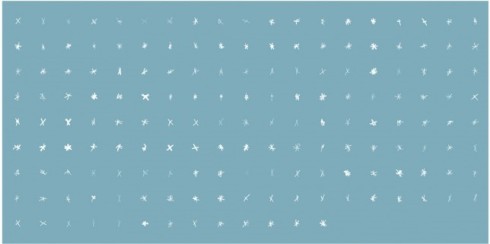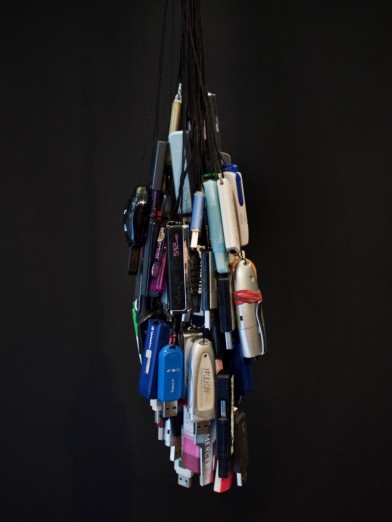Delphine Dallison pitched the following: “Glasgow School of Art launched The Hatchery this year as an online resource for creative people to take inspiration from libraries as a source or a site for creativity. Glasgow Women’s Library has also been leading the way in this area with the 21 Revolutions project*. I’d like to hear from other libraries about how they engage with artists and other creatives.” In this guest post, Delphine tells us how the session went.
* GWL recently won the Enterprising Museum Award for this project.
All images are used with permission.
The reason for pitching this session was because, although now a graduate trainee librarian at the Glasgow School of Art’s library, I had also previously studied at the Glasgow School of Art in Sculpture and Environmental Art and used libraries as the setting or inspiration for a number of projects. The first project I ever did in a library was at the GoMA Library, where I’d developed a series of postcards challenging gender stereotypes and then proceeded to slip them in between the pages of books, so that the books could become a method of surprise delivery of the art work. I was also obviously quite tickled by the idea that GoMA could be unwittingly promoting my work at such an early stage in my career as an artist. Later on, I pitched a similar project idea to the Glasgow Women’s Library, which although the project itself never really saw the light of day, led me into a collaboration with GWL which has lasted many years now and also was also the catalyst for GWL inviting me to be one of the 21 artists they commissioned as part of their 21st Anniversary celebration.
I went on from there to discuss a few of the artworks which were created by some of my fellow artists as part of that commission. The 21 artists and 21 writers were asked to take inspiration from books in the lending/reference collection of GWL and various items in the archive. One of the points I was keen to make when discussing that session was how the artists didn’t just limit their scope to the books, but actually investigated every aspect of the library.
For example, looking at the work of Shauna McMullan, 165 Stars, Found in GWL Lending Library, we can see how Shauna went through all the books taking photos of all the different marginalia and eventually narrowed it down to the asterisks she’d collected.
I’m always really moved by this artwork, as I feel that each asterisk captures that moment in time when a woman (or a man) felt so strongly about a passage in a book that they felt the need to single it out with a star. Was the star meant for themselves? Or were they hoping that the star would catch other people’s attention at a later time or day and encourage them to also partake in the reading of that exact passage?
Some of the other artists did indeed take inspiration from the books, but then felt drawn to doing a bit of detective work, like Amanda Thompson, who first came across an entry about Mary McCallum Webster, a little known Scottish female botanist, who made a great contribution to Scottish botany by writing ‘The Flora of Morayshire’. Through her research, Amanda Thompson found a memorial to Webster and was able to get it added to the Mapping Monuments to Women project.
Amanda’s project was a great example of how some of the women artists used the brief to highlight the lives of some of the women who contributed to Scotland’s heritage, but who’ve been left out of the history books.
One last example of how the GWL artists holistically used the library as inspiration was Ruth Barker, who designed an edition of scarves which when wrapped around someone beautifully illustrate what Ruth calls “the virtual hug” she receives as a welcome to the library whenever she comes to visit.
To find out more about the 21 Revolutions project, follow the link in the introduction or keep an eye open for the publication coming out in March 2014. Click on the images above to find out how to purchase limited edition copies.
The next point of discussion I wanted to raise was about the GSA library’s new online resource The Hatchery which was launched just after the summer. In this resource, the GSA librarians have been attempting to create a record of any instances during which students and artists have used the library as the source and site of their inspiration and artworks. The hope is than in future, students will be able to use the resource to feed their own inspiration and maybe librarians can look at ways of fostering similar instances of creativity in their own institutions. I went through a number of examples of artworks which were recorded in The Hatchery, or will soon be added, such virtual artist books which will only take the physical form of catalogue entry, exhibitions being inspired by our rare books collection or sculptures being made from long-lost USB memory sticks. (Click on the image for more information.)
This was really the launching point of the session’s discussion and it was heartening to see the warm response of the various library staff and other people attending the session. A number of people showed an interest in how The Hatchery will continue to develop in future and whether there will be scope for links to other libraries’ creative efforts.
The discussion also brought up interesting points about audiences for art in libraries, with Ally Proctor sharing the experience of a friend of hers who, while presenting artworks in a library in the US, came across an unexpected audience of homeless people who habitually use the library as a safe and dry refuge from the outdoor conditions. Could art in libraries be a means of reaching out to these disenfranchised audiences?
Karen McCauley spoke about how the Royal Conservatoire’s library has often hosted musical events, rather than visual art, obviously influenced by the students’ artistic focus and there was discussion of maybe developing some sort of exchange where students from the Conservatoire could perform at the GSA Library and GSA students could create art for the Conservatoire.
After the end of Library Camp Glasgow, Karen also brought up some new discussion points via her blog, which would be interesting to thrash out at a later event about how librarians evaluate the value and reach of creative efforts taking place in libraries. For me the idea of art in libraries is an important component of the political stance taken by environmental artists to displace art from its position of elitism and commercialism and instead make it available to everyone on a platform where the audience feels included in the work.
Secondly though, how do librarians speak about the work once it’s been produced? Do they have the necessary critical vocabulary to do so? In my first week as a trainee at GSA, there were indeed a lot of questions going about on what constitutes a crit term for the critical analysis session students at GSA regularly have to take part in to develop a critical awareness of their work. It was interesting to me to find out that none of the librarians at GSA had ever taken part in one, even though I’d imagine that their insights would be really valuable. I’m not sure though that there is such a need for complex language in the analysis of art. Most importantly, I feel that everyone should be able to provide a critique of an artwork, without in depth training (even though this may go against the past 3 years I spent studying at GSA). In 4th year Environmental Art, my crits used to get broken down in 3 parts:
– Describe what you see.
– Describe how it makes you feel.
– Interpret the meaning of what you see and how the work makes you feel.
Finally, depending on whether the interpretation matched the artist’s intention or not, the artwork would be deemed successful or unsuccessful. I feel this structure could easily be transferred to the context of a librarian discussing work taking place in their library, but equally could be passed on to any member of the public, trained or untrained, who wished to discuss an artwork.
Hopefully, this is only the start of many discussions on how libraries can provide the framework for many forms of artistic expression.
Delphine Dallison
d.dallison@gsa.ac.uk




One Response to “Library Camp Glasgow: Libraries as creative incubators”